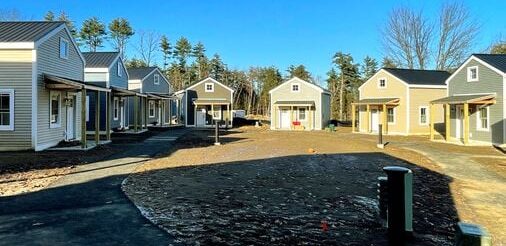Amid housing crisis, advocates celebrate innovation in N.H. – The Boston Globe

MANCHESTER, N.H. – When Maggie Randolph learned her employees were struggling to find housing, she took matters into her own hands. Her ability to staff her assisted living business in Durham depended on workers, who in turn needed stable places to live. “We needed creative ways to offer benefits because we were already heading into a staffing crisis,” she said during a housing forum at Saint Anselm College on Friday. First, Randolph and her husband, developer John Randolph, worked to build a seven-unit workforce housing building, capping rent at 30 percent of employees’ pay. Now, she’s tackling a larger project: 44 tiny homes at Back River Road in Dover. So far, 13 units are already occupied, Randolph said. Advertisement It’s allowed her to make new hires at her business, Harmony Homes, and she’s also been able to house two teachers who are new to the school system and three refugee families from Haiti. “This is exactly the type of people that we wanted to live here,” she said. Zoning would typically only allow nine single-family homes on the seven-acre parcel, but Randolph worked with the city of Dover on a special agreement called a transfer of development rights, allowing her to build more densely on half of the parcel, while conserving the other half. As part of the deal, Randolph agreed to cap rent in perpetuity at a fair market rate. The city of Dover is touting the arrangement as a creative way to tackle the city’s housing crisis. “In Dover, what really allows that creativity is our transfer of development right ordinance,” said Ryan Pope, housing navigator for the City of Dover. Through the agreement, developers pay for developing units above the threshold allowed by subdivision guidance on open space. Those funds go to the Conservation Commission. “We can conserve land that is environmentally sensitive, and allow for density where it makes sense,” Pope said. Advertisement Randolph’s story was one success highlighted during a housing forum at Saint Anselm’s Institute of Politics on Friday, as state and local officials and housing advocates celebrated the small wins amid a dire housing crisis that continues to plague the state. But the broader backdrop shows that progress easing regulations to allow for more housing is slow and incremental at best. The latest data from the NH Zoning Atlas showed meager changes from 2022 to 2023. For most types of housing, zoning regulations didn’t result in any change to available acreage for building. When it came to zoning changes, more jurisdictions made changes to loosen zoning than those that made restrictive changes. That meant zoning became more liberal in 135 districts, but it became more restrictive in 79 districts. One way to make more affordable homes is to allow them on smaller lots, measuring less than an acre and with under 200 feet of road frontage. But that’s only allowed on 14.4 percent of the state’s buildable land, according to the NH Zoning Atlas. The acreage grows by an additional 9 percent for buildings requiring a public hearing in order to gain approval. When it comes to two-family homes on small lots, even less acreage is available for building: only 10.6 percent of land. And that’s actually gone down slightly since 2022. Still, attitudes on housing are shifting rapidly in the state. Polling by Saint Anselm this year indicated that 60 percent of people in New Hampshire believe towns and cities should change their regulations to allow more housing to be built. Just three years ago, only around 29 percent of residents believed that was true. Advertisement Danica Malone, the town planner of Peterborough, said she has seen that change on the ground. “Community members have been coming out and they sit there in the meeting room and they say, ‘Huh, I’m in favor of that,’” she said. “That’s really new.” Amanda Gokee can be reached at [email protected]. Follow her @amanda_gokee.
